Cherry variety Lyubskaya
Lyubskaya is an old domestic variety of cherries of national selection with fruits of a late ripening period. It is famous for its high yield. The exact origin has not been established. In 1982, the first description of the variety appeared, the author of which is the famous scientist-fruit grower Nikolai Ivanovich Kichunov. It indicates that this variety has long been bred in the Korochansky district of the Kursk region. Another popular name for this cherry is Lyubka.
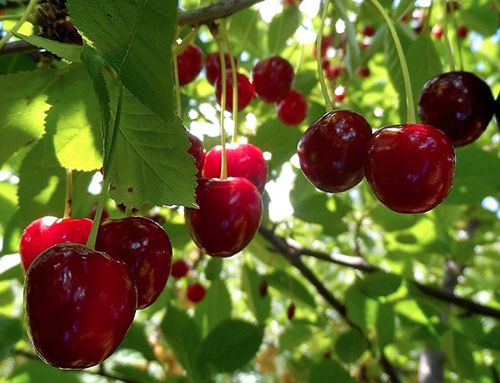
Since 1947, the variety has been submitted for state testing. In the same year it was zoned in the North-West (Novgorod, Kaliningrad and Pskov regions), Central (Moscow, Bryansk, Ryazan, Kaluga, Smolensk, Tula regions), Central Chernozem (Tambov, Kursk, Belgorod, Lipetsk, Oryol regions), Srednevolzhsky (Ulyanovsk, Samara, Penza regions and the Republic of Mordovia), Nizhnevolzhsky (Saratov, Volgograd, Astrakhan regions and the Republic of Kalmykia) and North Caucasian (Rostov region, Krasnodar and Stavropol Territories, Adygea and Kabardino-Balkar Republic, North Ossetia- Karachay-Cherkessia) regions.
The trees are small (no more than 2.5 meters high), weakly growing. The crown is rare, wide, round or spreading in shape, often weeping, drooping. The bark of the trunk is of a cracking type, colored brown-gray. The branches are curved; when they leave the trunk, they form angles close to 45 degrees. Annual branches have a drooping shape, their color is brown, with a silvery bloom. Vegetative buds slightly deviate from the shoot, have a rounded-conical shape; oval generative buds. Leaves 8.7 × 5 cm in size, dark green, elongated obovate or narrow oval, pointed at the base, with a smooth or rather abrupt transition to the top; leaf edges with double serrate serration. The leaf blade is slightly glossy, dense; glands are small, rounded, brown or yellow-brown in color, located on the base of the leaf blade in the amount of 1 - 2 pieces. Stipules are small, subulate-pointed. Root growth is practically absent.
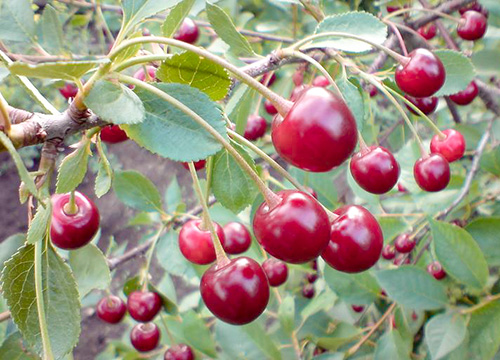
Flowers with a diameter of 3 - 3.4 cm, collected in inflorescences of 3 - 4 pieces. Petals with an elongated base and a rounded apex with a notch, slightly corrugated, concave, rounded. The calyx is ribbed, goblet type, greenish. The length of the column is 1 cm, the filaments are not more than 1 cm, the stigma of the pistil is below or on the same level with the anthers. Pedicels up to 2.5 - 3 cm in size.
By the nature of fruiting, the Lyubskaya variety is a typical bush cherry, fruit ovaries are formed mainly on annual branches.
Berries, as a rule, are of medium size (maximum fruit weight - 4 - 5 g), round-blunt-heart-shaped, with a rounded, slightly blunt top. In the ovaries 1 - 2 fruits are formed, much less often 3 - 4. The skin is thin, but strong, dark red, with a glossy sheen and numerous subcutaneous punctures; the ventral side of the cherries is lighter, with a clearly pronounced dark line of the seam. The funnel is shallow to medium depth, but wide. The juice is light red or red. Stone weighing 0.2 - 0.3 g (6 - 8% of the total weight of the berry), medium to large (10 × 8.5 × 7 mm), oval to ovoid, slightly pointed tip, rounded base ; the separability from the pulp is good. The stalks are thin, relatively long (from 3.5 cm and more), in unripe berries they hold firmly, in fully ripe berries they are medium. The pulp is colored dark red, the taste is sweet-sour, very juicy, delicate in consistency.
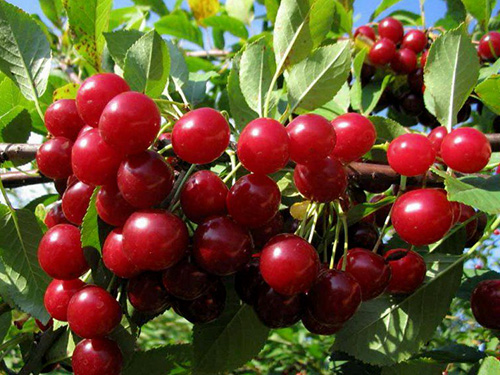
In the fruits grown in central Russia, the chemical composition contains: dry matter - 14.5%, the amount of sugars - 9.5%, free acids - 1.7%, ascorbic acid - 20 mg / 100 g of wet weight.For comparison, Lyubskoy berries grown in the Krasnodar Territory contain: dry matter - 15.1%, the amount of sugars - 10%, free acids - 1.8%, ascorbic acid - 11.7 mg / 100 g.
The taste of Lyubskaya cherries is mediocre and therefore, fresh berries are practically not consumed. This variety is intended primarily for technical use (wine, jam, compotes), drying and quick freezing.
The level of early maturity of the variety is high - the trees begin to bear fruit 2 - 3 years after planting, while rapidly increasing the yield. For example, in the fifth year of growth, the yield reaches 5 - 6 kg / der. Cherries ripen late, late July - early August. The variety is not prone to shedding, the fruits can hang on the branches for a long time, reaching their best qualities. Ripening of berries is simultaneous.
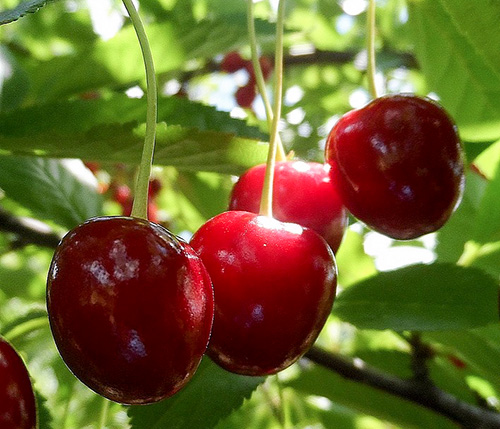
Potential productivity is assessed as high, while the real level of productivity is largely determined by the general condition of trees, overwintering conditions, and disease damage. In central Russia, productivity averages 10 - 12 kg of fruits per plant, but also often reaches 25 kg. There are cases when the maximum yields were collected up to 35 - 50 kg of fruits from a tree. Under the conditions of the Krasnodar Territory, the average productivity of trees aged from 7 to 16 years for 10 years of fruiting was 10.3 kg / v. The maximum yield was observed in 11-year-old trees - 54 kg / der. Fruiting is annual.
Flowering takes place in mid-late periods and, depending on weather conditions, lasts from 5 to 8 days.
Lyubskaya is characterized by a high level of self-fertility. But when planting together with pollinating varieties, the number of ovaries increases significantly. Suitable pollinators: Vladimirskaya, Zhukovskaya, Anadolskaya, Molodezhnaya, Fertile Michurina, Lotovaya, Shpanka early. Also, Lyubskaya herself is an excellent pollinator for many varieties of cherries.
The level of frost and winter hardiness of trees is estimated as medium: quite often freezing of the trunk and skeletal branches is recorded. This circumstance significantly reduces the lifespan of trees: if in the southern regions cherries live for 20 - 25 years, then in the middle lane - a maximum of 15 years. But the level of frost resistance of generative buds is assessed as high (an order of magnitude higher than that of the Vladimirskaya variety).
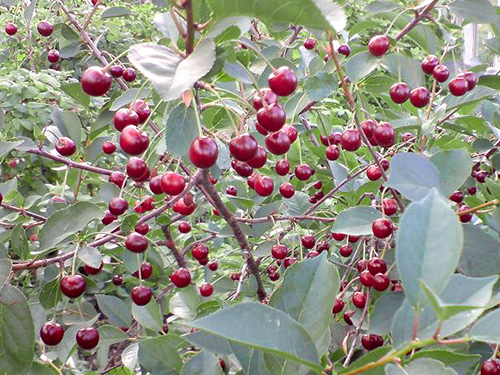
Resistance to common fungal diseases is low - the susceptibility to coccomycosis and moniliosis can reach 4 points. Sometimes plants are saved only by constant fungicide treatments.
Due to the insufficient level of frost and winter hardiness of wood, Lyubskaya is unsuitable for breeding in northern latitudes. The optimal cultivation area is the central and southern regions of Russia. As a matter of fact, this cherry got the maximum distribution in them.
The variety has an increased need for soil and care: it is very important to observe the optimal doses of organic and mineral fertilizers.
A high tendency of Lyubskaya to spontaneous kidney mutations (clones) was noted. They differ in plant habit, size and quality of berries, productivity, ripening times. Known are Lyubskaya late, Lyubskaya bouquet, Lyubskaya productive, etc.
Among the main advantages of this cherry are: a high level of potential productivity; good transportability of berries; small plant habit, allowing the variety to be used in intensive gardening.
The main disadvantages include: insufficient level of frost resistance of trees, strong susceptibility to fungal diseases, too sour taste of berries.
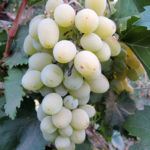
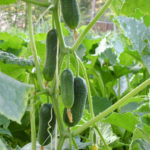
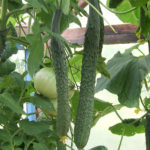
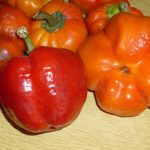
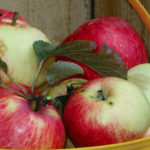
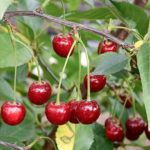



I've had Lyubskaya for 8 years. She quickly began to bear fruit, in the 3rd year they had already harvested about a liter. Zhukovskaya and Kharitonovskaya cherries are still growing in the garden. These are good pollinators for Lyubskaya. Now the yield per tree is about 2 - 3 buckets. The tree is of medium vigor, I would say - compact. I like it because it bears fruit every year. In the conditions of the Smolensk region, it froze a couple of times, slightly. Moniliosis and coccomycosis were not noted. But I practice preventive treatment with 1% Bordeaux liquid. The taste is mediocre, I use it for compote and wine.
“Lyubskaya” was planted next to “Vladimirskaya” with the expectation of improving the pollination of the latter. What did you like about this cherry? The fact that quickly began to give good yields. Of course, its taste cannot be compared with the "Vladimir" one. But, if we can eat "Vladimirskaya" only for food, since its yield is low, then from "Lyubskaya" I can cook both jam and compotes. This cherry tastes a little sour for me. Of the shortcomings - it does not tolerate frosty winters, cracks (frost cracks) appear on the bark of trees, I treat with garden var. He loves organic fertilizing very much, the yield then increases markedly.